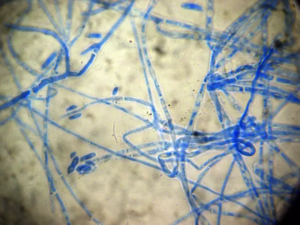Fusarium proliferatum
Classification
Eukaryota; Ascomycota; Sordariomycetes; Hypocreales; Nectriaceae
Species
|
NCBI: [1] |
Fusarium fujikuroi
Description and Significance
Fusarium proliferatum is a fungal species. It has been found on plants and in the soils of many environments with wide ranging environmental conditions.
It is important because it impacts the agricultural industry economically by infecting several different plant species making it a danger to human and animal health.
Genome Structure
The F9 strain of Fusarium proliferatum was 43.9Mb in size and had an average GC content of 48.28%.
Cell Structure, Metabolism and Life Cycle
Fusarium proliferatum can regulate the production of mycotoxins based on different nutrient conditions available to the fungi in the environment.
Ecology and Pathogenesis
F. proliferatum has been found in several plants and soils worldwide. As well as in many environments with diverse climactic conditions.
Fusarium proliferatum is known to infect many agricultural crops such as corn, wheat, asparagus, banana, etc. The main way Fusarium proliferatum causes disease to crops is by releasing a toxic substance known as mycotoxin. The mycotoxin can cause diseases such as esophageal and liver cancer, etc. and eventually lead to death in humans and animals.
References
Jurado, M., Marin, P., Callejas, C., Moretti, A., Vazquez, C., Gonzalez-Jaen, M.T. (2009). Genetic variability and Fumonisin production by Fusarium proliferatum. Food Microbiology. https://www.sciencedirect.com/science/article/abs/pii/S0740002009001816
Marín, P., Ory, A. de, Cruz, A., Magan, N., & González-Jaén, M. T. (2013). Potential effects of environmental conditions on the efficiency of the antifungal tebuconazole controlling fusarium verticillioides and fusarium proliferatum growth rate and fumonisin biosynthesis. International Journal of Food Microbiology. https://www.sciencedirect.com/science/article/abs/pii/S0168160513002699
Stepien, L., Waskiewicz, A., Wilman, K. (2014). Host extract modulates metabolism and fumosin biosynthesis by the plant-pathogenic fungus Fusarium proliferatum. International Journal of Food Microbiology. https://www.sciencedirect.com/science/article/abs/pii/S0168160514005248
Wang, L., Ge, S., Liang, W., Liao, W., Li, W., Jiao, G., Wei, X., Shao, G., Xie, L., Sheng, Z., Hu, S., Tang, S., & Hu, P. (2022). Genome-wide characterization reveals variation potentially involved in pathogenicity and mycotoxins biosynthesis of fusarium proliferatum causing spikelet rot disease in Rice. Toxins. https://www.ncbi.nlm.nih.gov/pmc/articles/PMC9414198/
Wu, Y., Li, T., Gong, L., Wang, Y., & Jiang, Y. (2019). Effects of Different Carbon Sources on Fumonisin Production and FUM Gene Expression by Fusarium proliferatum. Toxins, 11(5), 289. https://doi.org/10.3390/toxins11050289
Author
Page authored by Amber Smith, student of Prof. Bradley Tolar at UNC Wilmington.

